
Weather and climate of Punakha
One of the 20 Dzongkhags (districts) of Bhutan, Punakha is one of the most popular tourist destinations in the country, along with Thimphu, Paro, and Bumthang. The former capital of Bhutan until 1955, Punakha lies around 72 kilometers from the modern-day capital of Thimphu, although this trip takes around three hours by car. A lower-altitude district than its peers in tourist popularity, Punakha has a much milder climate throughout the year than Thimphu, Paro, and Bumthang, which makes it a pleasant place to visit even in winter.
Bhutan and Punakha Weather Overview
In general, the weather in Bhutan depends largely on the altitude. The higher you go, the lower the average temperatures and the drier it becomes, even in the rainy monsoon season. In the northern areas of the kingdom, the summers are drier than in the low-altitude south, and winters are much colder, with temperatures getting to well below freezing, especially at night.
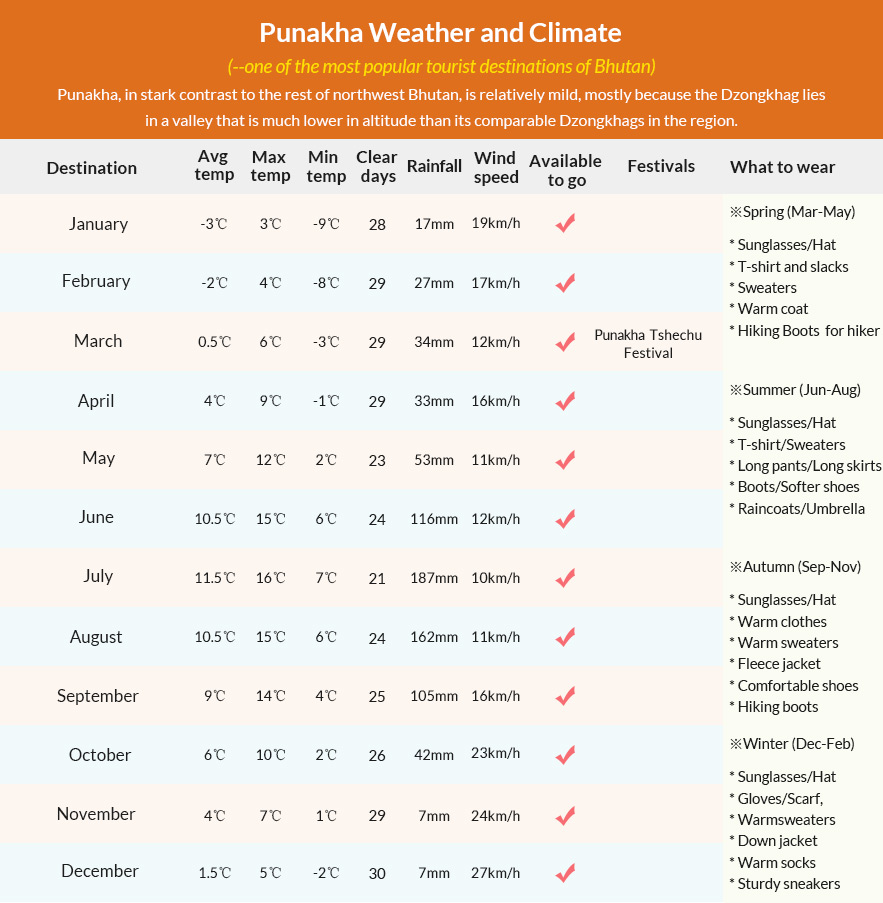 Table of Punakha Weather Guide
Table of Punakha Weather Guide
Punakha, in stark contrast to the rest of northwest Bhutan, is relatively mild, mostly because the Dzongkhag lies in a valley that is much lower in altitude than its comparable Dzongkhags in the region. Winters are generally milder, and summers are warmer, though it does mean that the district gets more rainfall than other districts on the same line of latitude. Monsoon rains in Punakha can be heavier than in the neighboring Thimphu, which makes it more ideal for visits from autumn to spring.
What is Punakha weather and climate by month?
Spring (March - May)
Average daytime temperature: 9°C
Average nighttime temperature: -2°C
Average wind speed: 18km/h
Average precipitation/month: 80mm
Clear days/month: 24
March, those temperatures have risen to between 10 and 24 degrees, though there is still the huge difference between night and day. Rainfall in January and February is minimal, but by March, is slowly increasing to around 33mm for the month.
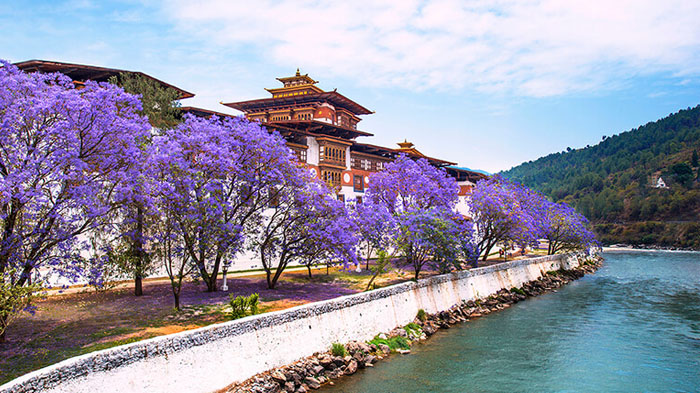 The stunning scenery of Punakha in spring
The stunning scenery of Punakha in spring
As spring progresses into April, the temperatures continue to increase, as does the rainfall. Highs of 25 degrees are seen throughout the month, and nights can be as warm as 13-14 degrees, but with around 133mm of rain across the month.
May, the last of the spring months, is increasingly warmer, with highs of up to 26 degrees and lows that can get as high as 17 degrees at night. May is also the pre-monsoon month in Punakha, when the rains start to get heavier, with as much as 156mm of rainfall within the month.
Summer (June - August)
Average daytime temperature: 15°C
Average nighttime temperature: 7°C
Average wind speed: 21km/h
Average precipitation/month: 136mm
Clear days/month: 22
June is the start of summer and the official start of the monsoon season, with rainfall almost doubling that of May, up to 640mm in just this one month. High temperatures can reach a blistering 27 degrees, and the warmer humid nights are only dropping to around 18 degrees, on average through the month.
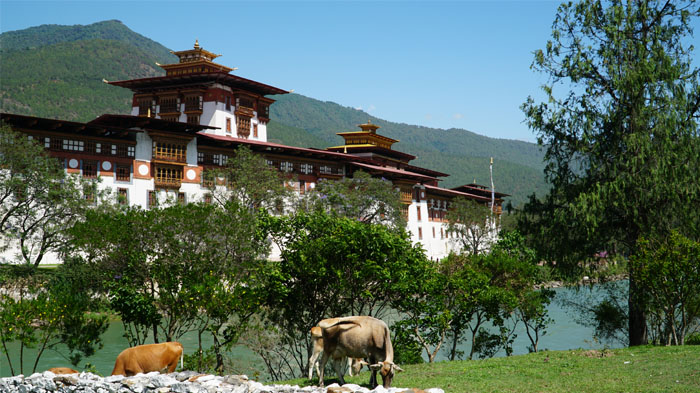 Punakha Dzong,the most important Dzong in Bhutan
Punakha Dzong,the most important Dzong in Bhutan
July is the hottest month of the year in Punakha, as well as the wettest. High temperatures reach up to 27-28 degrees, comparable with a south European summer, and the nights are a warming 20 degrees. However, with more than 740mm of rain falling across the month, the chances of staying dry are slim.
August is similarly hot, with highs of up to 27 degrees and lows of only 18-19 degrees. However, the monsoon season is starting its close, and the whole month sees a mere 330mm of rainfall, which is a considerable drop from July.
Autumn (September - November)
Average daytime temperature: 10°C
Average nighttime temperature: 0°C
Average wind speed: 16km/h
Average precipitation/month: 32mm
Clear days/month: 27
September is the last of the monsoon months, with only around 400mm of rainfall. It also sees a drop in temperatures, as the Punakha summer draws to a close. At night, the temperature barely reaches as high as 18 degrees, though the days are still hot, getting up to around 26 degrees, on average throughout the day.
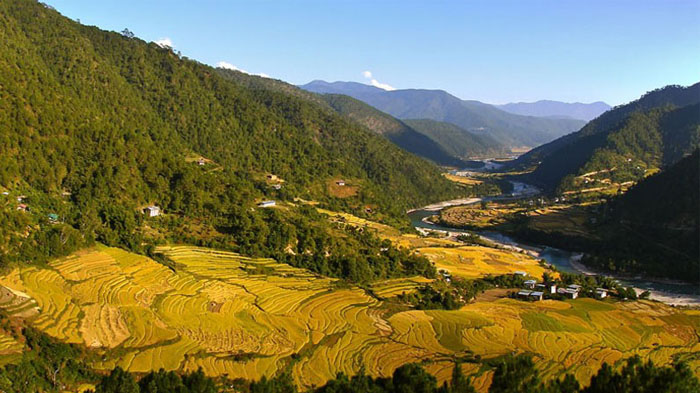 In the foreground lay golden fields and copses glittering in the sun.
In the foreground lay golden fields and copses glittering in the sun.
October is the start of the autumn tourist season, and the cooling temperatures and lower rainfall prompts the leaves to change color and fall. Temperatures range from 14 degrees at night to a comfortable 24 degrees during the day, and with just 120mm of rainfall, as the land starts to dry up. - See Best Time to Visit Bhutan.
November sees the temperatures drop ready for the coming winter, and nights quickly drop to as low as 9 degrees, while the days reach a cooler 20 degrees at most. Rainfall has almost stopped by now, and as December comes in, the rains are almost non-existent in the district.
Winter (December - February)
Average daytime temperature: 5°C
Average nighttime temperature: -8°C
Average wind speed: 19km/h
Average precipitation/month: 8mm
Clear days/month: 29
December’s temperatures can drop as low as 6 degrees at night, more akin to a more northerly climate then a Himalayan one. During the day, it can still get up to around 18 degrees, and as the year ends, the cooler and drier season of winter is well under way.
 Trekking in winter is one of the popular activities in Bhutan.
Trekking in winter is one of the popular activities in Bhutan.
January is the coldest month in Punakha, though it is comparably warmer than most of the neighboring Dzongkhags. Temperatures range from as high as 16 degrees during the day to as low as 5 degrees at night, which is a warm night for most Bhutanese.
February is also relatively warm, with temperatures ranging from 7 degrees to as high as 22 degree. Rainfall in January and February is minimal.
When is the best time to visit Punakha?
While most of the popular tourist destinations in Bhutan have distinct seasons for tourism, usually spring and autumn, in Punakha, the best time to come is from October to April, when there is much less rain and the temperatures are not as hot as in the summer months. March to May and September to November are still the peak seasons for Punakha, as they are for the rest of Bhutan, but if you are considering a cheaper vacation in Bhutan in the winter months from December to February, then Punakha is the ideal place to visit. You can even get in some great winter trekking in the area, as there is very little chance of the Dzongkhag ever seeing snow.
Is Punakha weather in Jul. and Aug. too rainy or Dec. and Jan. too cold to visit?
What is the monsoon season like from late June to middle Sep. in Bumthang?
Another of the more popular Dzongkhags in Bhutan, Bumthang has a much milder monsoon season that Punakha, with a lot less rainfall, even in the wettest month. July is the wettest month of the year in Bumthang, with only around 317mm of rainfall across the entire month. Temperatures are also cooler than in Punakha, with the highest temperature of the year barely reaching 22 degrees in the hottest months. A much lighter and cooler monsoon season, Bumthang is a great option for a summer trip to Bhutan. Is it possible to visit Punakha during the monsoon season?
Punakha is at a much lower altitude than the other popular tourist destinations in Bhutan, and as such suffers more from the Indian Southwest monsoon, much like the southern areas of the kingdom. From late June to the middle of September, you can expect heavy rainfall almost every day. While most monsoon countries do see the majority of the rains falling in the afternoons and evenings, Punakha does have monsoon rains that can last all day, though they are less frequent than you might think. Even in the wettest month, it is still possible to visit the Dzongkhag for a holiday, although there is no guarantee that it will not rain all day long.
>> Check more about Bhutan festival tours here
What is the winter like from December to February in Punakha?
The winter in Punakha is milder than most of the northern areas of Bhutan, and Punakha is often the holiday destination of choice for domestic tourists after a year-end holiday. A beautiful region of Bhutan, with lush green valleys and bright clear skies throughout the winter months, Punakha is the ideal winter getaway for those that do not want the higher temperatures of the south of the kingdom.
However, you will still need to pack those woolens and warmer shirts and jackets, as it can still get a little cold in the depths of winter. Compared to Thimphu and Paro, and even Bumthang, the nighttime temperatures in Punakha of as low as 5 degrees are relatively warm. But this is all relative, and five degrees is still pretty cold, especially if you are used to higher winter temperatures or heated homes. The average temperatures in the coldest month of winter are around 10 degrees, so a nice warm sweater, a scarf, and some mittens are a useful addition to your suitcase.
Besides the city tour what else we can do in Punakha winter?
As a popular trekking destination in the Himalayas, Bhutan is a major hotspot for some of the best high-altitude treks in the world. However, Punakha also has some great treks that you can try out, and once you are done with the delights of the city life, there is nothing better than to get back to nature and explore the countryside. The Punakha Winter Trek is a short and easy two-day trek that takes you from Chamina to Chorten Ningpo, though some of the Dzongkhag’s most spectacular scenery and landscapes. The trek does increase in altitude from the valley by around 1,000 meters, but the slopes are gradual and none of the trek is too hard. The hike passes through several small villages, rice fields, and forests, and offers some incredible views of the hills and mountains, as well as of the famous Phajoding Monastery.
>> Check more Bhutan trekking tours here
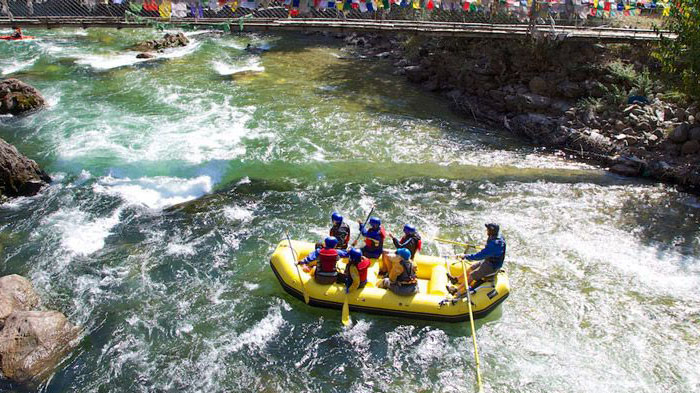 Enjoying the kayaking and white-water rafting in Punakha
Enjoying the kayaking and white-water rafting in Punakha
If you are into adventure sports, then the Mo Chhu is the ideal destination for you once you are out of the cityscape. Notably one of the best locations in Bhutan for kayaking and white-water rafting, the stretch of the Mo Chhu that runs through Punakha is the most popular for winter rafting, as the drier season makes for better rapids and faster flows.
Conclusion
Compared to the other popular destinations in Bhutan, including Thimphu, Paro, Bumthang, and Wangdue Phodrang, Punakha is the winter holiday destination for Bhutan’s tourism industry. A much warmer place to visit in the winter months, although pretty wet in the summer, this scenic area of outstanding natural beauty if often rated as one of the most beautiful areas in Bhutan. Add to that the amazing activities that can be done in the Dzongkhag throughout the year, and you have an amazing destinations that is unlike any other in the kingdom.

I am a tour guide in Tibet an was Born in Kham Tibet, I am the father of 2 little girls, bachelor's degree. I have more than 7-years experience of being a tour guide in Tibet. I am a warm, friendly, knowledgeable and attractive guy.


.jpg)



0 Comment ON "Weather and climate of Punakha"